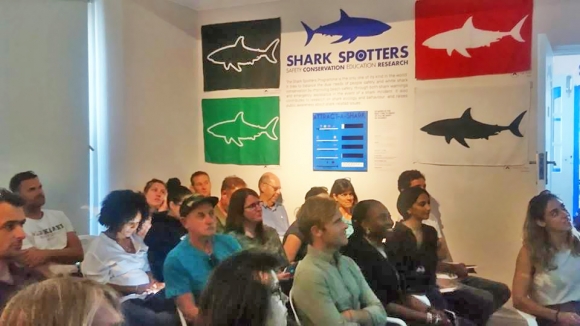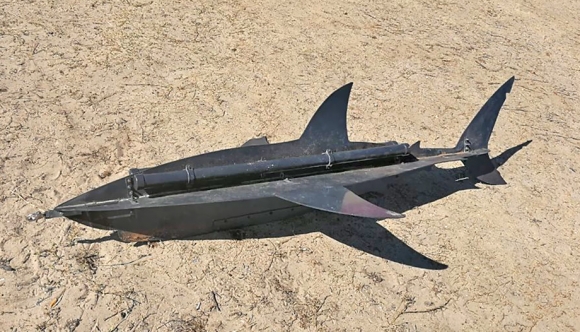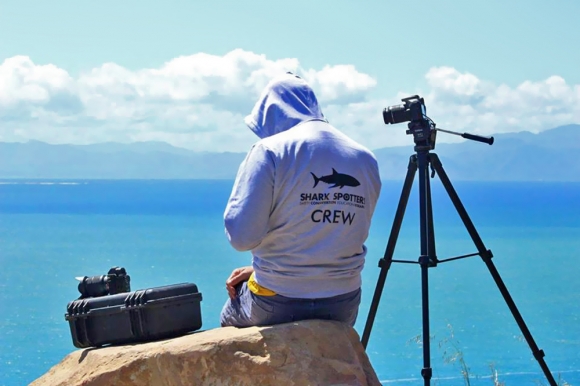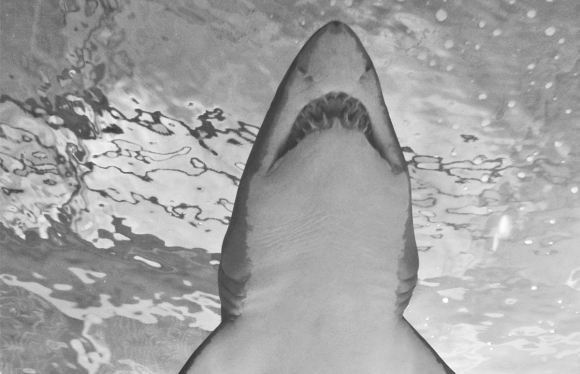
The Science of Shark Spotting
Tuesday 12 February 2019 The Cape Town Shark Spotters have announced the launch of a computerised, machine-learned shark detection system that could just change the game, writes Tatjana Baleta.

SHARK LAUNCHING: A small crowd of media and interested parties gathered for the launch.
Surfers and swimmers are familiar with the Cape Town Shark Spotters, perched on the mountain above False Bay, armed with binoculars and tasked with alerting the public to sharks in the water.
In an innovative new project, Shark Spotters have teamed up with Swiss Science consultancy Pattern Lab to test an automated shark spotting system that will beef up the detection of sharks.
The team set up a camera above Fish Hoek to feed hours of shark footage to a computer to teach it how to identify a shark. But there was a snag. Due to the recent record all-time low presence of white sharks at Shark Spotter-manned beaches, the project had to resort to towing a shark-shaped decoy behind a boat.

BLACK WHITE SHARK: Due to the low prevalence of sharks to 'teach' the system, they used this.
Just as the computer must be shown what a shark looks like, it must also be shown what it does not look like. This helps to avoid false positives – for example the misidentification of a floating clump of kelp as a shark.
The more data fed to the system, the better the program machine learns the identity of sharks. The project is focused on collecting this data, but aims in future to predict shark behaviour.
For example, will a shark that leaves the beach likely to continue (open the beach), or turn around and come back (keep the beach closed)?

SPOTTING EXPERTISE: While machine learning can help, you still need human eyes on the ground.
While the project has immense potential, there is still much testing to be done; “We still don’t know what we don’t know,” explained Pattern Lab’s Dr Krzysztof Kryszczuk at the project launch at Save Our Seas Education Centre, “But this project will increase knowledge on the technical limitations”.
Tricky environmental conditions such as glare and water sediment prevent the system from detecting a shark in the same way that it makes it difficult for spotters on the mountainside to. An automated shark sighting will always need to be confirmed by a spotter, who have years of experience.

SHAPING UP: Great White Sharks have a distinctive shape that the system is learning to ID.
Shark Spotter CEO Sarah Waries emphasised that this new technology will not replace shark spotting personnel, but help in upskilling them through the learning of new information and communications technology skills, as well as contribute to job creation by allowing expansion of the shark spotting programme.
Dr Kryszczuk explained that the technology aims to “make the job easier and more reliable, a bit like an assistant driving car that can keep the car in lanes, but doesn’t replace the driver”.
While the project is still in its early days, in the future we may see computer systems helping sharks and humans share the seas safely.


